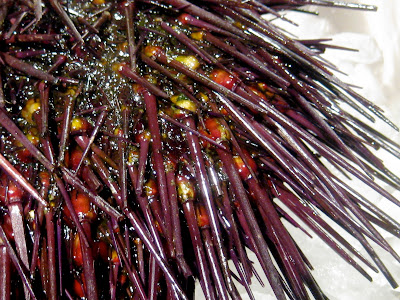urchin!
I've probably stated it before, but I LOVE sea urchin. Especially from the West Coast - and yes, there really is a difference. East Coast urchin, meh, but West Coast - mind blowing! Heck, it even LOOKS better. The mom was still in town, and as per usual when people visit and I'm working, they're left to their own devices for entertainment. Luckily, when I finished work the first thing I heard was, "I have a surprise for you!" Surprise, you say? I like surprises, but only if they don't disappoint me (logical, right?). Needless to say, this was the surprise. Santa Barbara urchin is one of those hard to come by items - one, because it's so perishable, and two, because it's so delicious all those Californians want to keep them for themselves! Needless to say, I'm glad that the mom knew this was a necessary purchase.
West Coast urchin are not only (generally speaking) bigger than East Coast, but spinier and darker in color. Most Easterners are an algae green color with shorter spines - as you can see, the Westerners have long, prickly spines with a great purple hue to them. Also, I'm entertained by the fact that it always reminds me of Surf's Up (seriously, a great movie) and this scene: Ivan the Urchin.
Needless to say, urchin are delicious, albeit difficult to handle. I give a hand to whoever it was that decided to break these guys open and eat the deliciousness within. When it comes to fresh urchin - the less, the better. Just a few accompaniments to amplify the flavor of the ocean you get from the roe (or tongues, as they like to call them). I used to be horribly terrified of urchin after tasting a particularly bad one - THEN, I read Jeffrey Steingarten's piece on them and it gave me a gigantic craving. Fortunately, I was visiting my brother in California, and it just happened to be urchin season - and I've never turned back again. It has a smooth, creamy texture, and it tastes just like the ocean. To be truly factual, they taste of what they eat - loads of kelp. Here's a fun fact - the urchin's only predators are humans and sea otters! At least two of us discovered the little gems inside these monsters. Brilliant!
If you ever stumble across fresh Santa Barbara urchin and you're not terrified of spiny, pokey things - get this. To open the urchin, it's easiest to cut it with a pair of scissors - start at the mouth (it looks kind of like a beak) and cut outwards. From there, cut off about the top quarter of the urching and gently remove. It really is a lot easier than you would expect!
Once the top is off, rinse out the insides - it would be best if you were sitting on the back of a boat and could just use the sea water to rinse, but unfortunately, that is not an option for me! The 'tongues' will still be attached to the wall of the urchin so you don't have to be TOO gentle.
Once you've rinsed a bit, gently take out each individual tongue from inside, hold it in your palm and gently rinse any of the remaining brown liquid from it - removing any other parts besides the roe, leaving you with a bright orange piece of deliciousness. For presentation purposes, clean out the inside of the urchin and place the tongues back where they came from. Urchin really do have beautiful shells!
Enough of that! It's time to get down to some tasty business. I took the tongues and squeezed the juice of one lemon over them, a bit of olive oil, and gently tossed to cover, being careful not to break up the pieces. I let them sit for a few minutes in the lemon-oil mixture while I toasted some olive oil brushed toast over my range. Once they are nice and golden, place one urchin tongue atop the toast, shave some lemon zest over top, sprinkle with sea salt and pepper, and garnish with cilantro. To die for!
With seafood, it may seem cliche to squeeze lemon over top, but in all actuality, it's brilliant. The acidity and brightness of the lemon juice actually amp up the flavor of the sea in fish. The best part about urchin is (obviously) eating it - not just for the flavor of it, but the fact that when you bite into it, it turns into creamy goodness - the consistency of a melted brie almost. It has an extremely velvety texture as well even though it may not look it at first sight.
Velvety goodness. You can't get much better than that! As much as I love this straight and raw, I'm urged to try cooking it - Joe Bastianich told me of a linguine recipe made with a slightly creamy tomato sauce that he finished with a bit of urchin - probably great considering his mother is Lidia. Nobu has a recipe for a flash-tempura urchin - wrapped with shiso & nori, then tempura'd. Chances are, I won't get my hands on another one of these for quite some time, so I've got some space for decision-making.












Comments